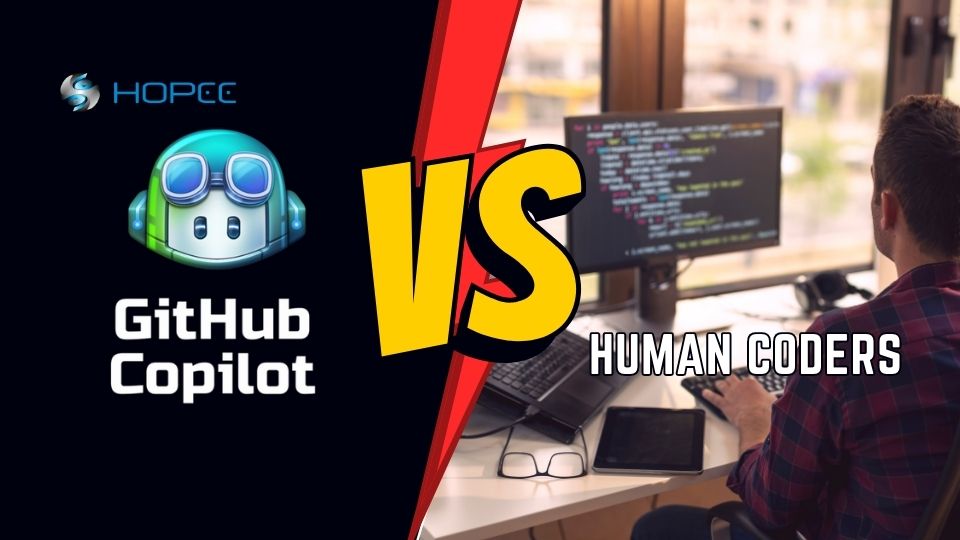As GitHub Copilot continues to make headlines as a revolutionary new tool for developers, many are wondering: can an AI program really outperform human coders? In this post, we’ll explore the strengths and weaknesses of Copilot and human coders, and take a closer look at which approach comes out on top in various scenarios.

1. What is GitHub Copilot?
First, let’s take a closer look at what GitHub Copilot actually is. At its core, Copilot is an AI-powered code assistant that uses machine learning to suggest code completion and generation. It is designed to integrate seamlessly with coding environments like Visual Studio Code, allowing developers to receive suggestions in real-time as they write code.
One of the unique features of Copilot is its ability to learn from millions of lines of code across various programming languages and libraries. By analyzing this vast amount of data, Copilot is able to suggest code snippets that are not only syntactically correct but also contextually relevant to the code being written.
2. What are the strengths of Copilot?
So what are the strengths of GitHub Copilot that make it a potential rival to human coders? Here are a few key advantages:
- Speed: One of the biggest benefits of Copilot is its ability to generate code suggestions quickly and efficiently. This can save developers a significant amount of time, especially when working on large, complex projects.
- Efficiency: Copilot is also highly efficient, able to generate code suggestions that are optimized for speed and performance. This can help to streamline the development process and reduce the number of errors that occur.
- Contextual understanding: Copilot’s machine learning algorithms enable it to analyze and understand the context in which code is being written. This means that it can generate more accurate and relevant suggestions than traditional autocomplete tools.
- Learning and adaptability: Finally, Copilot is able to learn and adapt over time, continually improving its suggestions based on user feedback and usage data. This means that it can become increasingly effective at generating code that meets the needs of developers.
3. What are the strengths of human coders?
Of course, it’s important to remember that human coders also have a number of strengths that Copilot can’t match. Here are a few key advantages of human coders:
- Creativity: One of the biggest strengths of human coders is their ability to think creatively and come up with innovative solutions to coding challenges. This is something that Copilot is not yet capable of replicating.
- Intuition: Human coders also have a sense of intuition and understanding of how different pieces of code fit together. This can be especially valuable when working on complex projects with multiple dependencies.
- Communication: Human coders are able to communicate and collaborate with other developers in a way that Copilot cannot. This is especially important for large projects that require coordination between multiple team members.
- Experience and expertise: Finally, human coders bring years of experience and expertise to the table, allowing them to make informed decisions and solve coding challenges that may be difficult for Copilot to tackle.
4. When does Copilot come out on top?
Given the strengths and weaknesses of both approaches, when does Copilot come out on top? Here are a few scenarios where Copilot may be the preferred option:
- Writing boilerplate code: One area where Copilot excels is in generating boilerplate code. This is code that is necessary for the functionality of a program but is not unique to a specific project. Copilot can generate this code quickly and efficiently, saving developers time and effort.
- Debugging: Copilot can also be useful when debugging code. By analyzing the context of the code, Copilot can suggest potential solutions to errors and bugs, helping to streamline the debugging process.
- Familiar codebases: Another scenario where Copilot may come out on top is when working with familiar codebases. If a developer is working on a project in a language or library that they are not particularly familiar with, Copilot can help to suggest code that is contextually relevant and correct, without the developer needing to spend time researching and learning the syntax and conventions.
5. When do human coders come out on top?
On the other hand, there are also scenarios where human coders come out on top. Here are a few examples:
- Creativity: As mentioned earlier, human coders are able to think creatively and come up with innovative solutions to coding challenges. This is especially important when working on projects that require outside-the-box thinking or unique approaches.
- Non-standard problems: Copilot is trained on a massive amount of code, but it may not always have the knowledge or expertise to solve more unique or non-standard coding problems. In these cases, human coders with specialized knowledge and experience may be better equipped to come up with solutions.
- Collaboration: Collaboration and communication are essential in many development environments, especially larger projects with multiple team members. Human coders are able to communicate and work together in a way that Copilot cannot, making them an essential part of many development teams.
6. Who comes out on top?
So, who comes out on top in the GitHub Copilot vs. human coders debate? The answer is not so straightforward. While Copilot can certainly offer a lot of benefits to developers, it is not a replacement for human coders. Instead, it should be viewed as a tool that can help to augment and streamline the development process, allowing developers to focus on the more creative and complex aspects of coding.
In conclusion, GitHub Copilot is an impressive new tool that has the potential to revolutionize the way that developers write code. However, it is important to remember that human coders still have a lot to offer in terms of creativity, intuition, and expertise. The best approach is likely to be a combination of both Copilot and human coders, with each bringing their unique strengths to the table. By working together, developers can create more efficient, accurate, and innovative code than ever before.




